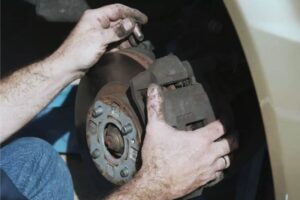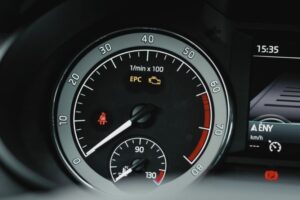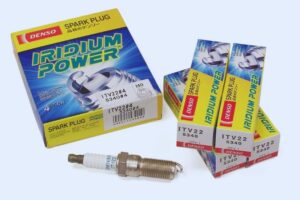The ABS light on your dashboard lets you know the anti-lock braking system isn’t working properly. This article will list some of the common reasons the ABS light comes on.
The anti-lock braking system shares the same components as your traction control system. When the ABS light sets off, it’s probably caused by a failing ABS module, damaged wheel speed sensors, low fluid levels, and a deactivated system.
Read on to learn the top causes of an ABS light coming on and what to do about it.
What Is the ABS Light?
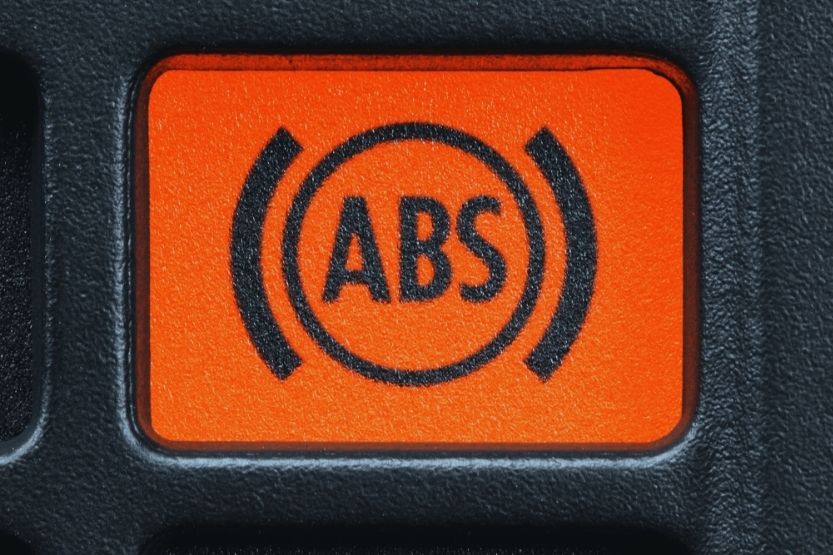
Anti-lock Braking System
ABS is the acronym for an anti-lock braking system. All passenger cars manufactured in 2004 have an anti-lock braking system as a standard feature.
Prevents the Car’s Wheels from Locking up When Braking Hard
Like the name hints, the anti-lock braking system prevents your car’s wheels from locking up when you brake hard.
Engine Control Unit (ECU) Determines Which Wheel Is About to Lock Up
The advanced ABS sensors on each wheel let the engine control unit (ECU) know which four wheels are about to lock up and skid. As a result, the ECU sporadically lets go of the brakes on each wheel so that you can maintain better control of your car during extreme braking.
Amber, Orange, or Yellow ABS Light
On your dashboard, you’ll notice that the ABS light has an amber, orange, or yellow color and is marked with the letters “ABS.” This ABS light tells you if the anti-lock braking system is working properly or not.
How Does ABS Light Work?
Automatically Checks the ABS When You Start the Car
The ABS light and other warning lights will automatically come on briefly every time you start your car. Your car regularly checks the anti-lock braking system upon starting it.
Turns Off When Properly Working
If it doesn’t find any issues, it turns off. If it stays on, it means there are components or systems in your car that aren’t working correctly and have been disabled.
Number of Blinks Indicates a Specific Trouble Code
The ABS light might blink a couple of times in some cars and doesn’t turn off. The number of blinks indicates a specific trouble code, which can help you find out the real issue. To be sure, read your owner’s manual or information on the internet.
Now that you know what the ABS light means let’s focus on what causes it to come on and what you should do about them.
7 Reasons Your ABS Light Is On (and What to Do)
1. Bulb Check
Most Cars Have Long-lasting LED Bulbs
The dashboard of most cars today uses LED bulbs, which are expected to last for many years. Older cars might not be equipped with long-lasting LED bulbs, so they’ll require replacement more often.
ABS Light Is On Due to Bulb Check Glitch
It’s normal for these bulbs to switch off after a specific period. Cars usually perform a bulb check procedure to see if the bulbs of dashboard warning lights are working properly. There are a few instances wherein the ABS light stays on because of a bulb check glitch.
ABS Dashboard Light Burn Out Due to a Blown Fuse
If the bulb of your ABS dashboard light does burn out, the most likely cause is a blown fuse. Like most electrical systems, an ABS light has a fuse that cuts off the circuit when there’s too much power supplied to the system.
Electric Device Failure
One possible reason for a blown fuse is the failure of an electrical device, which could draw excessive amounts of power to keep working properly. This can lead to circuit overloading, which causes a short and a blown fuse.
If the cause is a blown fuse, the most logical solution is to replace it with something new and identical. As much as possible, get a certified technician to do the job.
Dashboard Warning Light Bulb Replacement Cost
The average cost of a dashboard warning light bulb could cost around $10 to $30. The price could go higher if you’re going to replace it with a high-end or specialty bulb.
2. Faulty ABS Control Module
The good news is the ABS module itself is rarely the cause of a malfunction in the braking system. Most of the time, the sensors or their wiring are the problem.
Contaminated with Metal Shavings and Other Debris
Speed sensors malfunction because they become contaminated with metal shavings and other debris, which the brakes produce over time. Sensor wires could become damaged, resulting in weak or no electrical connection.
But if your car’s wheels start to lock up when you lose traction, you have a reason to suspect that the ABS module is the problem.
Excessive Corrosion
This might be due to excessive corrosion, which prevents the module from receiving information from the wheel speed sensors. Other times it becomes damaged due to overheating, overcurrent, and impact.
Signs of a Malfunctioning or Failing ABS module
- The wheels of your car will begin to lock up during heavy braking.
- The speedometer will display inaccurate speed reading. Sometimes, the speedometer needle stays at 0 miles per hour (mph).
- The ABS light or the check engine light will illuminate. This is one of the common signs of a faulty ABS.
- You’ll eventually need to increase your pedal effort to produce the same amount of braking force. But the increased pedal effort could also mean that the brake pads are worn out, or the brake booster is failing.
If you’re wondering, you can continue driving even if your car has a bad ABS module. But if there’s already a problem with your standard brake system, take extra care or stop driving and pull off the road.
During an emergency, don’t repeatedly pump your brakes while braking hard. You’ll lose the benefits of the anti-lock braking system. Instead, apply firm pressure on the brake pedal. Don’t remove your foot until your car comes to a complete stop.
How to Fix a Faulty ABS Control Module
- Ideally, you’d want to immediately bring your car to a licensed mechanic or the dealership. This issue might need different kinds of repairs, depending on the cause.
- Try restarting your car. If that doesn’t switch off the ABS light, it’s your cue to take your vehicle to your mechanic. Whenever the ABS light comes on, it triggers a code that can help your mechanic determine which component of the anti-lock braking system is causing the problem.
- When repairing the ABS control module, you can replace it with a new, rebuilt, or remanufactured module. Instead of buying a new one, an expensive option, you can opt for a rebuilt or remanufactured module to save money.
3. Low Fluid Levels in the Reservoir
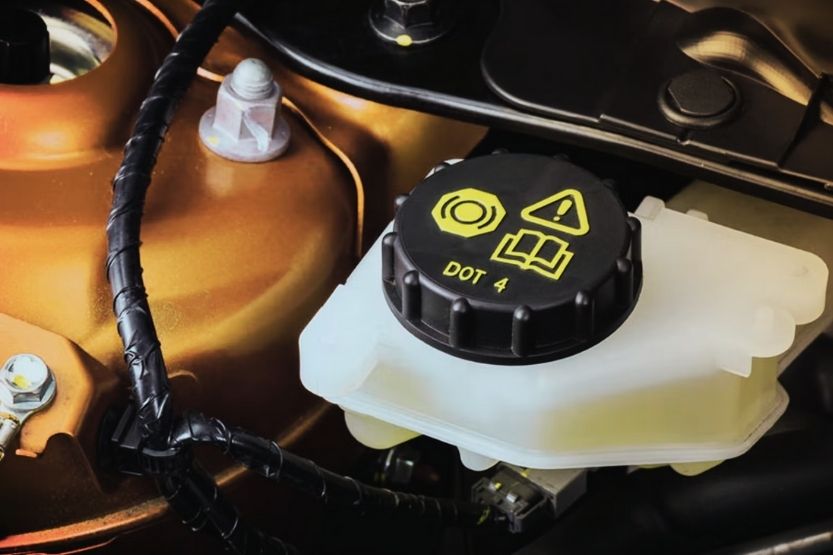
Hydraulic Anti-lock Braking System
The anti-lock braking system is hydraulic. This means it operates using a cylinder, which presses against a fluid under pressure. Since it’s hydraulic, it needs a consistent fluid supply at the correct volume.
ABS Comes with a Fluid Level Sensor
The anti-lock braking system comes with a fluid level sensor. As the name says, these sensors keep track of the amount of brake fluid in the master cylinder reservoir.
If the fluid is old or falls below a certain minimum level, the ABS light will usually come on, and your brakes will stop working properly.
Symptoms of Low Brake Fluid
- Soft or spongy brakes
- Grinding or squealing noise coming from the brakes
- Brake pedals that are hard to push
- Worn out brake pads (less than 1/4-inch thickness)
Regularly Check the Brake Fluid
To make sure you’ll drive a safer car, regularly check your brake fluid. Do it every time you get an oil change. To be more specific, check it every six months or two years. You can use a test strip to determine the brake fluid condition.
Do Not Use DOT 5 Brake Fluid
Cars with an anti-lock braking system shouldn’t use DOT 5 brake fluid. Since it’s silicone-based, it repels water.
This is a problem because it doesn’t mix well with the moisture that will form in the brake system. As a result, the moisture will boil or freeze, which leads to fading brakes.
Again, why is my ABS light on? The most common reason for an illuminated ABS light includes a failing ABS module, faulty wheel speed sensors, low fluid reservoir level, and a turned-off system. The ABS light is connected to your vehicle’s traction control system.
4. Dirty or Damaged Wheel Speed Sensor
Detect the Rotation and Measure the Speed of Each Wheel
The function of wheel speed sensors or vehicle speed sensors (VSS) is to detect the rotation and measure the speed of each wheel. They send this information to the anti-lock braking system (ABS) or electronic stability program(ESP) through electrical signals.
ABS Stabilizes the Car by Shifting the Power to Different Wheels
If the ABS or ESP detects a problem based on the wheel speed data, it stabilizes your car by shifting the power to different wheels and preventing the locking of wheels during braking.
May Stop Working Due to Corrosion
Wheel speed sensors may stop working properly because of corrosion. This affects the signal strength of the sensors, as well as the air gap spacing (0.016 inches to 0.050 inches), which prevents the anti-lock braking system and traction control system (TCS) from working correctly.
Clogging Due to Presence of Dust and Dirt
Another reason wheel speed sensors fail is clogging due to dust and dirt. If they’re dusty or full of grime, they cannot send accurate data from the wheels to the ABS or ESP control unit.
Instead of making the necessary adjustments, the sensors deactivate the ABS and TCS. It stays that way unless you restart your car or fix the root problem.
Signs of a Faulty Wheel Speed Sensors
- The ABS light is illuminated on the dashboard.
- The driver-assist features of your car, such as the stability control and traction control, are turned off.
- The speedometer isn’t working properly.
ABS Speed Sensor Repair Cost
It’s relatively simple to replace ABS speed sensors. The procedure will typically take around an hour. You can repair a defective ABS speed sensor for $80 or lower, depending on the brand and model.
But since even a minor glitch in the sensors could lead to a serious accident, it’s best to let the experts do it.
Fortunately, the ABS light usually comes on due to dirt accumulation in the speed sensors. You’ll need to clean the sensors to get them working properly again.
How to Clean ABS Wheel Speed Sensors
Steps for cleaning the ABS wheel speed sensors:
- Read your car’s owner’s manual to know the location of the ABS wheel speed sensors. There are usually one to four sensors.
- Prepare the necessary tools, such as jack (not designed to hold a load), jack stands (essential), soft microfiber cloth, socket extension, wrench, and sockets.
- Loosen the lug nuts on the wheel where the speed sensor is located. Your car should be on the ground while doing this to avoid any accident.
- Jack the front of your car (depending on your speed sensors), and then use a jack stand to hold it in place.
- Turn the steering wheel on one side, but it should be the opposite side you’re currently working on.
- Find and remove the ABS wheel speed sensor that needs cleaning.
- Once you’ve successfully removed the speed sensor, wipe it clean using a soft microfiber cloth—no need to use any chemical-based cleaning solution. But if the speed sensor is full of grime, you can clean it using a mild, soapy solution. Be careful when handling this device.
- Reattach the sensor in the same way you took it out.
ABS Light Comes On [Why Is It On and How to Turn It Off]
5. Disabled System
Modern Cars Have a Button That Deactivates ABS
Most modern cars have a button that allows you to deactivate or enable the anti-lock braking system or traction control system.
Turned Off ABS Will Activate the Indicator Light
If you accidentally turn off the ABS, it will activate the corresponding indicator light. But even if the ABS or TCS is disabled, it can turn itself back on once you restart your car.
Consult Your Owner’s Manual
Many cars usually have a different way of disabling the braking and traction control systems. So, consult your owner’s manual if you don’t know where the ABS disable button is or how to enable/disable it.
Benefits of Turning Off the Anti-lock Braking System
But why would you turn off your car’s driver safety features, such as the anti-lock braking system?
- Disabling it would be beneficial if you’re trying to get your car out of deep mud or snow.
- You’ll have more control over how your car moves by the steering action.
- It also allows you to do a “donut” maneuver.
- It helps you drive up steep and icy inclines.
The traditional brakes will still work even if your anti-lock braking system or traction control system is off.
An off anti-lock braking system could increase stopping distance, locked-up wheels, and problems relating to your ability to steer during braking.
6. Hydraulic Pump Failure

Provide the Required Pressure to Turn the Power Steering Pump
The job of the hydraulic pump is to offer the required pressure to turn the power steering pump, which helps you turn the steering wheel.
If you’ve ever driven without power steering, you know how difficult it is to turn a stiff steering wheel. The good news is most modern cars don’t have the same problem, and it’s all thanks to hydraulic pumps.
How Does the Hydraulic Pump Work?
The hydraulic pump delivers pressurized fluid to the steering linkage whenever you turn the steering wheel. The steering linkage is responsible for moving the front wheels properly.
Once that happens, it causes the hydraulic pump to boost the brake fluid pressure to keep the wheels on the ground and make the steering wheel turn quickly.
Fortunately, hydraulic pumps are strong enough to last for years. The longevity of these devices will depend on various factors, including their quality, type, intensity, and style of your driving.
Common Causes of Hydraulic Pump Failure
- Corrosion may form on the pump through the years.
- The extremely high load prevents it from working properly, which in turn causes the input shaft to break or twist.
- Hydraulic fluid contamination due to the build-up of debris or improper filtration.
- There are changes in the pressure settings, which could exceed the design of the hydraulic pump.
- The hydraulic fluid is abnormally low.
- The hoses are of the incorrect size, which prevents proper fluid flow.
You could probably repair a defective hydraulic pump yourself. But don’t be fooled by its relatively simple design.
Hydraulic Pump Repair Cost
If you don’t have an excellent technical knowledge of hydraulic pumps, it’s better to seek the help of a skilled mechanic or your dealership. The cost of repairing it could fall between $200 and $350. But if the problem is big, you might need to spend more than $400 on a new one.
7. A Blown Fuse
You can find the ABS fuse box in the passenger side engine compartment. Like most electrical device fuses, the ABS fuse protects the control units and wiring by breaking the circuit with too much current flow.
When a fuse blows, your car will display a few symptoms to help alert you, such as an illuminated ABS light and tires that constantly lock up.
What Would Cause the ABS and Brake Light to Come On?
Conclusion – Why Is My ABS Light On?
The ABS light comes on because it wants to alert you of a possible problem with your anti-lock braking system and other components that affect how it works.
When it illuminates on your dashboard, you should stop driving and pull over to the side of the road to find the cause. But to make sure you don’t make the problem worse, seek the help of an experienced mechanic or trusted auto repair shop.
Read next:
What Is DTC in a BMW [DTC Warning Light and Button Explained]

![5.7 Hemi Problems [7 Most Common] 5.7 Hemi Problems](https://roadsumo.com/wp-content/uploads/2021/11/5.7-Hemi-Problems-150x150.jpg)
![Ford 6.2 Engine Problems [5 Most Common and How to Fix] ford 6.2 engine problems](https://roadsumo.com/wp-content/uploads/2021/06/ford-6.2-engine-problems-150x150.jpg)


![ABS Light Comes On [Why Is It On and How to Turn It Off] abs light comes on](https://roadsumo.com/wp-content/uploads/2022/08/abs-light-comes-on-150x150.jpeg)
![Battery Light on Dashboard [9 Reasons Why It's On] battery light on dashboard](https://roadsumo.com/wp-content/uploads/2022/03/battery-light-on-dashboard-150x150.jpg)
